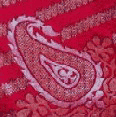
Calico Museum of Textiles, Ahmedabad

Calico Museum of Textiles, Ahmedabad
The Retreat, opp. Underbridge, Shahibag, Ahmedabad, Gujarat
India 380 004
The museum has a library and guide service.
The museum was initially housed in the Calico Mills, which belonged to the family. As the collection and its related resources grew, everything was moved to the Sarabhai family home in the Shahibag district of Ahmedabad. The home was later turned into a museum complex. The museum is now operated by the Sarabhai Foundation, a non-profit charity that remains closely connected with the Calico group.
The museum currently includes a large collection of Indian and related textiles, exhibition galleries, as well as a research centre and library. There are permanent exhibitions about Indian dyeing, weaving and wood block printing techniques, as well as displays on various themes, such as regional embroideries; Indian textiles influenced by the Mughal and provincial courts (from the seventeenth to the nineteenth centuries); as well as urban and regional costumes from the eighteenth to the mid-twentieth centuries.
The museum publishes extensively on the history, the international trade and the production techniques of Indian textiles. In particular, they have been involved in the production of two series, Historical Textiles of India (ed. John Irwin, then keeper of the Indian Section of the Victoria and Albert Museum, London), while the second was a Contemporary Textile Craft Survey of India (ed. Alfred Bühler, former Director of the Museum für Völkerkunde und Schweizerisches Museum für Volkskunde, Basel). Other scholars associated with the museum are Moti Chandra and Pupul Jayakar. The collection has influenced the textile design courses of the National Institute of Design, also located in Ahmedabad.